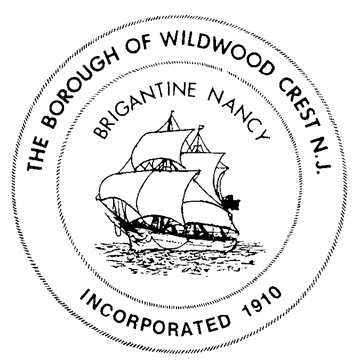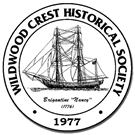The Battle of Turtle Gut Inlet
THE SEAL OF THE BOROUGH OF WILDWOOD CREST
honors the men of the brigantine “Nancy” and their heroic deeds in the Battle of Turtle Gut Inlet
in the year 1776.

Turtle Gut Inlet, once located in the vicinity of Toledo Avenue in today’s Wildwood Crest, was at one time the division between Five Mile Beach to the north and Two Mile Beach to the south. Filled in by the county in 1922, it has long been forgotten, but its history has given us much to remember.
The Battle of Turtle Gut Inlet — a little-known but authentically documented naval encounter during the Revolutionary War — took place on June 29, 1776.
The importance of Philadelphia to the Colonies as a port made it absolutely essential that merchant ships bound there with supplies be given safe conduct. To accomplish this, a constant effort to elude the British blockade of Delaware Bay was carried on by the ships of the Continental Navy, ably assisted by the sloops and brigs native to the area of Cape May. The pilots of these small boats knew the region well and were especially adept at dodging in and out of the small harbors and inlets to escape capture by the British. It was at one of these inlets — Turtle Gut — that a naval battle was fought. On Friday, the 28th of June, 1776, the brigantine Nancy was sighted off the coast of Cape May. Under the command of Captain Hugh Montgomery, she was bound from the Virgin Islands with a cargo of munitions for the Continental Army. As the Nancy came into view, an urgent message was sent to Captain John Barry of the Continental frigate Lexington, anchored near the mouth of the Delaware Bay, that two British warships were already pursuing her.
The Lexington, accompanied by the continental frigate Wasp, set out to aid the Nancy, anchoring close to Cape May to wait out the night. In the early light of dawn, Captain Barry sighted the Nancy heading in for shore with the British warships in hot pursuit. Realizing the necessity for quick action, Barry ordered out the barges from the Lexington and Wasp and, taking personal command of the expedition, directed his oarsmen toward the Nancy. They found the brigantine hard aground in Turtle Gut Inlet and under heavy fire from the British warships. Barry and his men boarded the Nancy and began the double operation of manning the Nancy’s guns to ward off the attack of the warships, while at the same time unloading the valuable cargo of munitions and storing it safely ashore.
The Nancy was taking a terrific bombardment from the enemy guns, but somehow managed to return enough fire to discourage a boarding party from the warship Kingfisher. Barry knew, however, that he and his men were already on borrowed time. Though only about two-thirds of the precious cargo of gunpowder had been unloaded, Captain Barry ordered the men to abandon the ship, but not without leaving a calling card for the British. He ordered about fifty pounds of gunpowder to be poured in the ship’s mainsail and wrapped as tightly as possible. This would act as a fuse leading to the remaining powder below deck. With their men safely in a boat alongside, the two Captains set fire to the mainsail and jumped over the side, but the last to leave the ship was reportedly a seaman who stayed behind to retrieve the ship’s flag. They made the few hundred yards to shore safely, stopping only to pull the seaman and his precious flag into the boat.
Meanwhile the long boats from the Kingfisher had taken the lowering of the flag as a sign of surrender and closed in quickly to board the ship. The first seven British sailors who reached the Nancy raised a cheer of victory as they climbed aboard, but at that moment the gunpowder exploded with a roar that, according to record, “was heard forty miles above Philadelphia”. Thus by noon on June 29 the Battle of Turtle Gut Inlet had ended. The enemy ships retreated and the precious gunpowder was loaded onto the frigate Wasp and sent safely up the Delaware Bay.
It was a proud moment in the history of our country, and an important step forward in the career of young Captain John Barry. By 1794 he would be known as Commodore Barry, “the father of the American Navy”.
A marker commemorating the Battle of Turtle Gut Inlet stands today at Miami and New Jersey Avenues, across from Sunset Lake, in Wildwood Crest.
